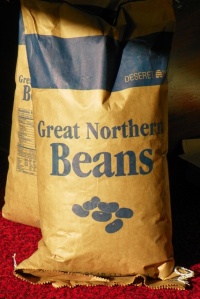Storage – Long Term
WHEN YOU STORE basic commodities, it’s nice to have an idea of how far your supplies could stretch in an emergency situation, i.e. natural disasters, unemployment, illness, or other situations that might cause shortage in your bank account or depletion of supplies at the markets.

Foods bought in bulk are less expensive. If used regularly, they can be stored in a five-gallon bucket. They can also be sealed in a Mylar pouch
DO NOT BE OVERWHELMED by amounts you read for a longer term. Think 1 month; 3 months; etc. Build your supplies gradually and evenly. DO NOT go into debt to purchase food storage. Make sure you store your commodities in optimal conditions (dry and cool) for longer-lasting storage.
REMEMBER: 1 YEAR of commodities an adult could survive on will also be a 1 MONTH supply for 1 adult + 11 NEIGHBORS 🙂
Although the suggested amounts of commodities below are for basic survival, once in your storage, they should be used as regularly as possible in your menus. This rotates them gradually, improves your ability to use them in tasty ways, helps your family members comfort levels with what you have stored AND raises your awareness of how happy you would be to have other essential items in your in your pantry to go with the beans, quinoa, etc.!
THE BEST PLAN: Build a menu/supply of what you eat regularly and incorporate these basic commodities into your menu on a regular basis.
“Essentials” are necessities other than the five basic commodities listed below. Chocolate is included in my store. Other items for me would be favorite seasonings and sauces that would give variety to some of my longer basic commodities. Non-food items such as freezer bags or aluminum foil should also be considered. There are no rules or limits to “essentials.”
- Salt Yeast Baking Soda Baking Powder
- Vinegar Multiple vitamins Chocolate !
OIL 13# (# = “pounds”)
such as
- Shortening
- Vegetable oil
- Mayonnaise
- Peanut Butter
SUGAR 60#
- Cane sugar, granulated and powdered
- Honey Jam
- Molasses, brown sugar
- Alternative natural sweeteners
MILK 75#
- Nonfat dry
- Canned milk
- Powdered cocoa
LEGUMES 60# – see link
- Black beans
- White beans
- Pinto beans
- Split pea
- Lentil
- Mung beans – used for sprouting
- Etc.
GRAINS 300 #
- Flour
- Wheat
- Barley
- Corn/cornmeal
- Popcorn
- Oats
- Rice
- Millet
- Pasta
- Quinoa

Trackbacks & Pingbacks